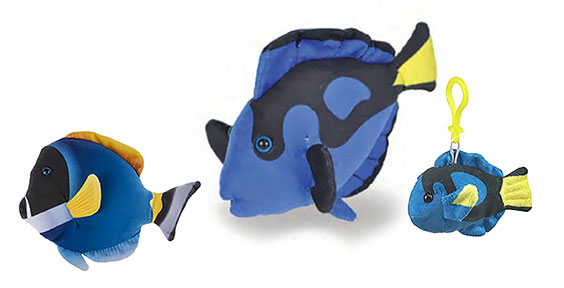

The Ocean is full of interesting creatures. Find some colorful plush Blue Tang stuffed animals at the Oceanarium.
These little Blue Tang fish stuffed animals are made by Wild Republic and Wildlife Artists, and are in our sponsor's online gift shop. Find them at www.jeanniescottage.com.
The blue tang, scientifically known as paracanthrus hepatus, is a small, brightly colored fish native to coral reefs in the Indo-Pacific Oceans.
The blue tang has a few common names including hippo tang, regal blue tang, palette surgeonfish, Pacific regal blue tang and blue surgeonfish. The surgeon, or doctor, fishes and the tangs carry curious weapons, to which they owe their names. On each side of the base of the tail
they bear a sharp spine. These spines are shaped like a surgeon's lancet, the the fish can point them forward and outward, to gash or maim other fishes as it swims by. Appropriately enough, the order is known as Acanthuroidei ("spiny tails"). However, in some species the spines are replace by flat, bony plates.
Blue tangs have a royal blue body, yellow tail, and black palette shape on their body. They are able to adjust the intensity of their hue from light blue to deep purple. Adult blue tangs can grow up to 10-12 inches long and weigh around 1.3 lbs, males tend to be larger than females. The fish is flat with an oval body shape, smaller scales, and a slightly pointed nose.
Blue tangs are herbivores, and they actively browse the surface of coral reefs, searching for their favorite algae.
The average lifespan of blue tang in the wild is 30 or more years.However, in captivity, blue tangs live for approximately 20 years.
Blue tangs reproduce through a behavior known as broadcast spawning. They congregate in groups; the females releasing eggs and males releasing sperm into the water. The blue tang then swims off. The eggs are then carried away by currents.
Blue tang live in coral reefs and inshore rocky areas in the Indo-Pacific Oceans. Often found at depths of 6 – 131 feet, they make their homes in small crevices and holes in the reef where they are able to stay protected from predators.
They can be found in the reefs in Japan, Philipines, Indonesia, the Great Barrier Reef of Australia, Sri Lanka, New Caledonia, Samoa and East Africa.
Blue Tangs are not endangered. Their flesh is poisonous.
Class: Actinopterygii | Order: Acanthuriformes | Family: Acanthuridae | Genus Species: Paracanthurus hepatus



